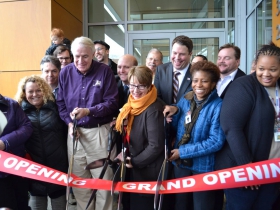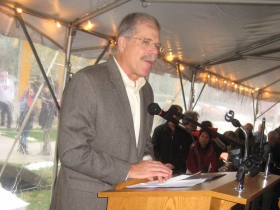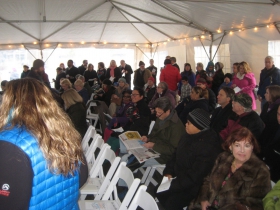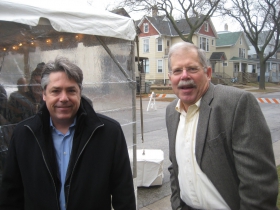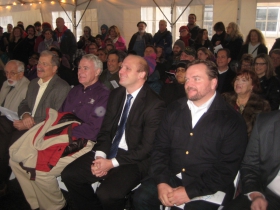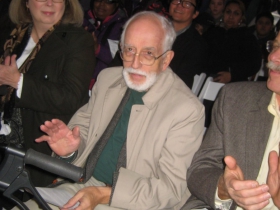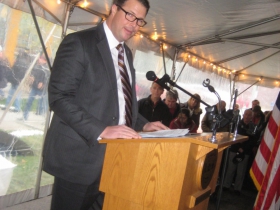Huge Turnout for East Library Opening
It was a truly an East Side event, and a crowd with tons of notables celebrated history in the making.
“Your attendance speaks volumes about support for libraries,” a standing-room-only audience of over 400 people heard from speaker Paula Kiely, the City of Milwaukee Librarian. She was addressing attendees at the opening of the East Branch of the Milwaukee Public Library Saturday, November 22nd.
Some 400 people huddled inside a tent erected on N. Cramer St. and, as she spoke, a line formed outside the tent as hundreds of Milwaukeeans waited for the ribbon to be cut so they could see the interior of the new mixed-use development located at what Ald. Nik Kovac called “the crossroads of the East Side.”
It says something about this city that the hottest ticket in town was the opening of a library. And it says something about Milwaukee that its innovative program of library construction will be a model for other cities. Library Science students, architects, developers and urban planners will almost certainly use the Milwaukee model as a template.
“It’s not just a library, but a gathering place for the East Side,” Kiely said. The new facility has a fireplace in a living-room-like setting, meeting rooms for collaboration, private study areas, a community room and a fantasy world for children, including a fabulous Lego zone.
Visitors can also “bring in coffee as long as it has a top on it, and you are welcome,” Kiely said. The Milwaukee Public Library system serves over 2.2 million visitors a year, Kiely noted, adding that number considerably exceeds the attendance at many other cultural and sports activities in town.
That which is in the library depended upon that which is above the library, Mayor Barrett reminded the audience. The 99 apartments of The Standard at East Library provided the key to the development of the new library, he said, reducing the development costs by millions of dollars.
“An idea came that we’d have a mixed-use building,” the mayor recounted. The Villard facility was constructed with “Grandparent housing” above — apartments for grandparents who were raising their children’s children. (This is a growing demographic in impoverished neighborhoods.) “It was a magnificent success,” the mayor said, adding that his reaction was, “Wow! That worked. Let’s do it again!”
Whereas the Villard location was in an area troubled by declining property values and high rates of poverty and unemployment, “the dynamic on the East Side is much different. This is a valuable property. And I am happy to report it is back on the tax rolls,” the mayor said.
“Do you want to rent an apartment? They don’t have a lot of wild parties in libraries,” he joked. The mayor said, “this is about community and neighborhood. By 2020 every neighborhood library will be a 21st century library and learning center,” — and, significantly, on the tax rolls. The mayor was followed by Kovac, the East Side alderman and library trustee.
He began his remarks by thanking the mayor for his leadership on the library — and on the streetcar — and said the building, as developed, was better than he expected. He said he heard no complaints about it, and had none himself.
Kovac was followed by Milwaukee Public Library Board of Trustees President John Gurda. Gurda, a local historian, is perhaps one of the best customers of the library, Kovac said. “He does his research in the Zeidler Room of the Central Library, and his neighborhood library is Bay View,” Kovac said of the House Confidential honoree.
Gurda, reading from prepared remarks, called the new library a “step forward and back to the future.”
The first neighborhood libraries were located in storefronts, and it was not until the 1960’s, when the former East Branch building was constructed that they were housed in standalone facilities. (The first “East Branch” was opened in 1909 in a Plymouth Congregational Church at E. Wells and N. Van Buren streets; it moved to a storefront at 2022 E. North Ave. in 1912, where it served the community until the building at 1910 E. North Ave. was opened in 1968.)
Gurda was followed by Ryan Schultz of HSI Properties, the developer of the site. He said the project, which took only 15 months to build, “will serve this generation, the next generation and beyond.” It was “an extremely challenging project,” on its tight urban site. “North Avenue traffic doesn’t slow down for a construction project,” he said.
The final speaker was Ryan Daniels, Executive Director of the Milwaukee Public Library Foundation. He reminded the audience that they have until December 21st to make a contribution to the library, and to ensure that “you can get your name on the wall of donors.” [To make your tax-deductible donation, click this secure link: http://mpl.org/support/. Call 414 286-8720 for more information.]
Scene in the Crowd
Among the attendees was Mike “Ringo” White, the great found-object artist and E. North Ave. resident whose work would be an ideal addition to the walls of the facility. Mary Schanning, an assistant city attorney who deals with real estate matters was in the crowd, preparatory to heading to the office for some weekend work, hopefully on some new and yet-unannounced city development project. Former Ald. Don Richards was in a front-row seat. He represented the Villard Library district in the past. Ted Bobrow caught the action in his role as a lively citizen, and Scott Weber walked down the street from his new apartment not far away. Ald. Terry Witkowski was one of the elected officials in the audience — but he was outside the tent. “He represents the South Side, so they should let him inside the tent,” the mayor joked.
Pat Small was there to promote his opposition to the County’s planned sale of O’Donnell Park to NML, saying the property is worth much more than the insurance giant is offering, and that selling a boondoggle like the O’Donnell park is still a mistake even if it is a boondoggle. Gallery owner and author Dean Jensen came by to take a look and to drop off a book he had borrowed. The ubiquitous Jeff Bentoff was there representing the Water Tower neighborhood, and Russ Drewry of Brady Street stopped by in part to talk with Kovac about the Pecoraro Sausage (“Pepperoni Cannoli”) building that he is considering buying from the city. Both the building and its legal condition are a mess. No surprise there. Sam McGovern-Rowen, who lost to Kovac in a primary in their first run for alderman was there with his family. Rowen now serves in a newly created position to lead redevelopment of the city’s branch libraries.
But perhaps the most remarkable thing of the event was the tremendous number of just ordinary folks who will make use of this building. Kids flocked to the computers, the learning niches, the books — and especially the Lego Zone. Though Kovac says he has no complaints about the library, I have one: Where is the Lego zone for adults? It’s not fair that the kids have one all to themselves!
Photo Gallery
More photos in our recent library tour.
Past Coverage
- Eyes on Milwaukee: New East Library is a Jewel – Jeramey Jannene – November 21st, 2014
- Doors Open: Inside the Standard at East Library – Dave Reid – September 30th, 2014
- Hard Hat Tour: The Standard at East Library – Jeramey Jannene – July 17th, 2014
- Friday Photos: Standard Nears Completion – Jeramey Jannene – May 30th, 2014
- Plenty of Horne: Owner of Strad Violin Tips Her Identity – Michael Horne – February 6th, 2014
- Hard Hat Tour: North Avenue Boomtown – Jeramey Jannene – January 23rd, 2014
- Photo Gallery: New East Library Complex Rising – Dave Reid – November 24th, 2013
- Rebuilding Another Library – Maria Corpus – October 10th, 2013
- Photo Gallery: East Library Groundbreaking – Jeramey Jannene – July 30th, 2013
- Photo Gallery: Temporary East Library Opens – Jeramey Jannene – July 1st, 2013
- Friday Photos: Say Goodbye to East Library – Jeramey Jannene – June 7th, 2013
- Eyes on Milwaukee: A Redesign for Hi Hat Garage – Jeramey Jannene – December 13th, 2012
- Eyes on Milwaukee: Did Donovan Make Bauman Soil His Pants? – Jeramey Jannene – May 24th, 2012
- East Library Gains Zoning Approval, Rest of District Held – Jeramey Jannene – May 21st, 2012
- City Land Sale for East Library Redevelopment Held at Committee – Dave Reid – March 28th, 2012
- East Library Redevelopment Advances at City Plan Commission – Dave Reid – February 28th, 2012
- East Library Redevelopment Update and Estimated Schedule – Jeramey Jannene – February 9th, 2012
- HSI/WiRED Properties Proposal Picked for East Library – Jeramey Jannene – November 10th, 2011
- Mixed Use East Library Proposals Meet the Neighbors – Jeramey Jannene – September 15th, 2011
Political Contributions Tracker
Displaying political contributions between people mentioned in this story. Learn more.
- July 22, 2019 - Nik Kovac received $100 from Pat Small
- March 29, 2016 - Michael Murphy received $100 from Jeff Bentoff
- March 28, 2016 - Michael Murphy received $100 from Terry Witkowski
- March 28, 2016 - Michael Murphy received $50 from Paula Kiely
- March 9, 2016 - Terry Witkowski received $50 from Jeff Bentoff
- February 2, 2016 - Nik Kovac received $50 from Pat Small
- January 14, 2016 - Terry Witkowski received $75 from Jeff Fleming
- December 4, 2015 - Terry Witkowski received $100 from Paula Kiely
- October 7, 2015 - Terry Witkowski received $50 from John Gurda
- May 7, 2015 - Nik Kovac received $200 from Pat Small
- April 15, 2015 - Nik Kovac received $144 from Jeff Bentoff
Plenty of Horne
-
Villa Terrace Will Host 100 Events For 100th Anniversary, Charts Vision For Future
 Apr 6th, 2024 by Michael Horne
Apr 6th, 2024 by Michael Horne
-
Notables Attend City Birthday Party
 Jan 27th, 2024 by Michael Horne
Jan 27th, 2024 by Michael Horne
-
Will There Be a City Attorney Race?
 Nov 21st, 2023 by Michael Horne
Nov 21st, 2023 by Michael Horne


